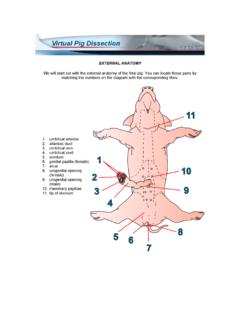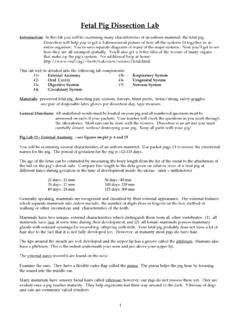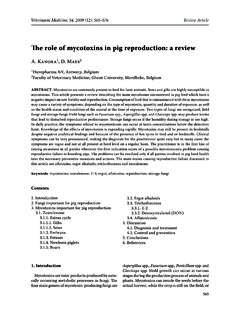Transcription of CLASSICAL SWINE FEVER FINAL - Home: OIE
1 1 CLASSICAL SWINE FEVER (hog cholera) Aetiology Epidemiology Diagnosis Prevention and Control References AETIOLOGY Classification of the causative agent Family Flaviviridae, genus Pestivirus, one serotype divided into three major genotypes and ten subtypes. Closely related to ruminant pestiviruses causing bovine virus diarrhoea and border disease. Resistance to physical and chemical action Temperature: Readily inactivated by cooking: heating meat to C for 30 minutes or 71 C for one minute. Survives months in refrigerated meat and years in frozen strains are partially resistant to moderate heat (56 C). pH: Stable at pH 5-10. Rapidly inactivated at pH < or pH > Chemicals/Disinfectants: Susceptible to ether, chloroform, -propiolactone ( ).
2 Inactivated by chlorine-based disinfectants, cresol (5%), sodium hydroxide (2%), formalin (1%), sodium carbonate (4% anhydrous or 10% crystalline, with detergent), ionic and non-ionic detergents, and strong iodophors (1%) in phosphoric acid. Survival: Moderately fragile and does not persist in the environment. Sensitive to drying and ultraviolet light. Survives well in pens during cold conditions (up to 4 weeks in winter). Survives 3 days at 50 C and 7-15 days at 37 C. Survives in meat during salt curing and smoking for 17 to >180 days depending on the process used. Virus persists 3 4 days in decomposing organs and 15 days in decomposing blood and bone marrow.
3 EPIDEMIOLOGY Virulence of disease is related to strain of virus isolate, age of pig and immune status of herd. Virus is highly contagious. Acute disease is still the prevalent form in younger animals, with subacute and chronic forms often observed in older animals. Hosts Pigs and wild boar are the only natural reservoir of CLASSICAL SWINE FEVER virus. All feral and wild pigs, including European wild boar, are susceptible. Collared peccaries were susceptible in one study, but recovered in 10 days. Transmission Mainly by the oral and oronasal routes, via direct or indirect contact. Direct contact between animals (secretions, excretions, semen, blood) Spread by farm visitors, veterinarians, pig traders Indirect contact through premises, implements, vehicles, clothes, instruments and needles Neighbourhood effect during outbreaks in areas of high pig farm density: airborne transmission over short distances (up to 1 km in one study) Insufficiently cooked waste food fed to pigs: most common means of entry into free countries Transplacental infection: may create inapparent carrier piglets or congenital abnormalities Wild boar populations may harbour virus.
4 Domestic pigs in the affected area are at a high risk; and biosecurity is crucial 2 Sources of virus Blood, secretions and excretions (oronasal and lachrymal discharges, urine, faeces and semen) and tissues of sick or dead animals, including meat Congenitally infected piglets are persistently viraemic and may shed the virus for 6 12 months before dying Infection routes: ingestion (most common), contact with the conjunctiva or mucous membranes, skin abrasions, genital transmission, artificial insemination, percutaneous blood transfer Occurrence The disease occurs in much of Asia, Central and South America, and parts of Europe and Africa.
5 Many countries are free of the disease. For more recent, detailed information on the occurrence of this disease worldwide, see the OIE World Animal Health Information Database (WAHID) Interface [ ] or refer to the latest issues of the World Animal Health and the OIE Bulletin. DIAGNOSIS Incubation period is 2 14 days. Clinical form varies with the strain of virus, the age/susceptibility of pigs and the occurrence of other pathogens in the herd (herd health status). Clinical diagnosis Acute form (more virulent virus strains and/or younger pigs) FEVER (41 C) Anorexia, lethargy Severe leucopenia Multifocal hyperaemia and/or haemorrhagic lesions of the skin Conjunctivitis Enlarged, swollen lymph nodes Cyanosis of the skin especially of extremities (ears, limbs, tail, snout) Transient constipation followed by diarrhoea Vomiting (occasional) Dyspnoea, coughing Ataxia, paresis and convulsion Pigs huddle together Death occurs 5 25 days after onset of illness Mortality in young pigs can approach 100% Chronic form (less virulent virus strains or partially immune herds)
6 Dullness, capricious appetite, pyrexia, diarrhoea for up to 1 month Ruffled appearance of pigs Growth retardation Apparent recovery with eventual relapse and death within about 3 months Congenital form (outcome depends on virulence of virus strain and stage of gestation) Fetal death, resorption, mummification, stillbirth Abortion Congenital tremor, weakness Runting and poor growth over a period of weeks or months leading to death 3 Born clinically normal but persistently viraemic with no antibody response: important intermittent shedders of virus until dying in 6 12 months (late onset form). Mild form (usually older animals; outcome depends on virulence of virus strain): Transient pyrexia and inappetence Recovery and (lifelong) immunity Lesions Acute form: Lesions are usually complicated by secondary infections Leucopoenia and thrombocytopenia Enlarged haemorrhagic lymph nodes are common Widespread petechiae and ecchymoses, especially in the skin, lymph nodes, epiglottis, bladder, kidney and rectum Severe tonsillitis with necrotic foci sometimes occurs Multifocal infarction of the margin of the spleen is characteristic.
7 Nearly pathognomonic but occurs infrequently with currently circulating strains Lungs may be congested and haemorrhagic Encephalomyelitis with perivascular cuffing is common Chronic form: Lesions are usually complicated by secondary infections Button ulcers in the caecum and large intestine mucosa Generalised depletion of lymphoid tissue Transverse striations of unmodelled growth cartilage at costochondral junctions in growing pigs Haemorrhagic and inflammatory lesions are often absent Congenital form Central dysmyelinogenesis, cerebellar hypoplasia, microencephaly, pulmonary hypoplasia, hydrops and other malformations. Differential diagnosis Varies with form of the disease African SWINE FEVER (indistinguishable clinico-pathologically.)
8 It is essential to send samples for laboratory confirmation.) Septicaemias: erysipelas, eperythrozoonosis, salmonellosis, streptococcosis, pasteurellosis, actinobacillosis, and Haemophilus parasuis Haemorrhage: porcine dermatitis and nephropathy syndrome, haemolytic disease of the newborn, coumarin poisoning, thrombocytopenic purpura Runting: post weaning multisystemic wasting syndrome, enterotoxicosis, SWINE dysentery, campylobacteriosis Abortions: Aujeszky s disease (pseudorabies virus), encephalomyocarditis virus infection, porcine reproductive and respiratory syndrome, parvovirus Nervous signs: viral encephalomyelitis, salt poisoning Congenital infection with ruminant pestiviruses: Bovine virus diarrhea, Border disease Laboratory diagnosis Procedures Samples Identification of the agent Method of choice for detecting herds early in infection is to collect whole blood and tissues from multiple febrile or recently dead animals.
9 4 Tonsil Lymph nodes (pharyngeal, mesenteric) Spleen Kidney Distal ileum Blood in EDTA or Heparin (live cases) Refrigerate and ship to laboratory as quickly as possible For details, refer to the OIE Terrestrial Manual Identification of the agent Reverse transcription polymerase chain reaction (RT-PCR) or real time RT-PCR. Virus isolation in cell culture, with virus detection by immunofluorescence or immunoperoxidase. Confirmatory identification with monoclonal antibodies. Direct immunofluorescence test on cryostat sections of organs from affected pigs. Serological tests Antibodies develop only during the third week of illness: submit sera from convalescent pigs and from contact herds when >3 weeks have elapsed since suspected contact took place.
10 Serum should also be tested from sows with suspected congenitally infected litters. Antibodies persist for life in recorded pigs. The following may be used for serological diagnosis or surveillance, and are also tests prescribed by the OIE for screening for international trade: Neutralisation peroxidase-linked assay Fluorescent antibody virus neutralisation ELISA For more detailed information regarding laboratory diagnostic methodologies, please refer to Chapter CLASSICAL SWINE FEVER in the latest edition of the OIE Manual of Diagnostic Tests and Vaccines for Terrestrial Animals under the heading Diagnostic Techniques . PREVENTION AND CONTROL No treatment is possible.
















